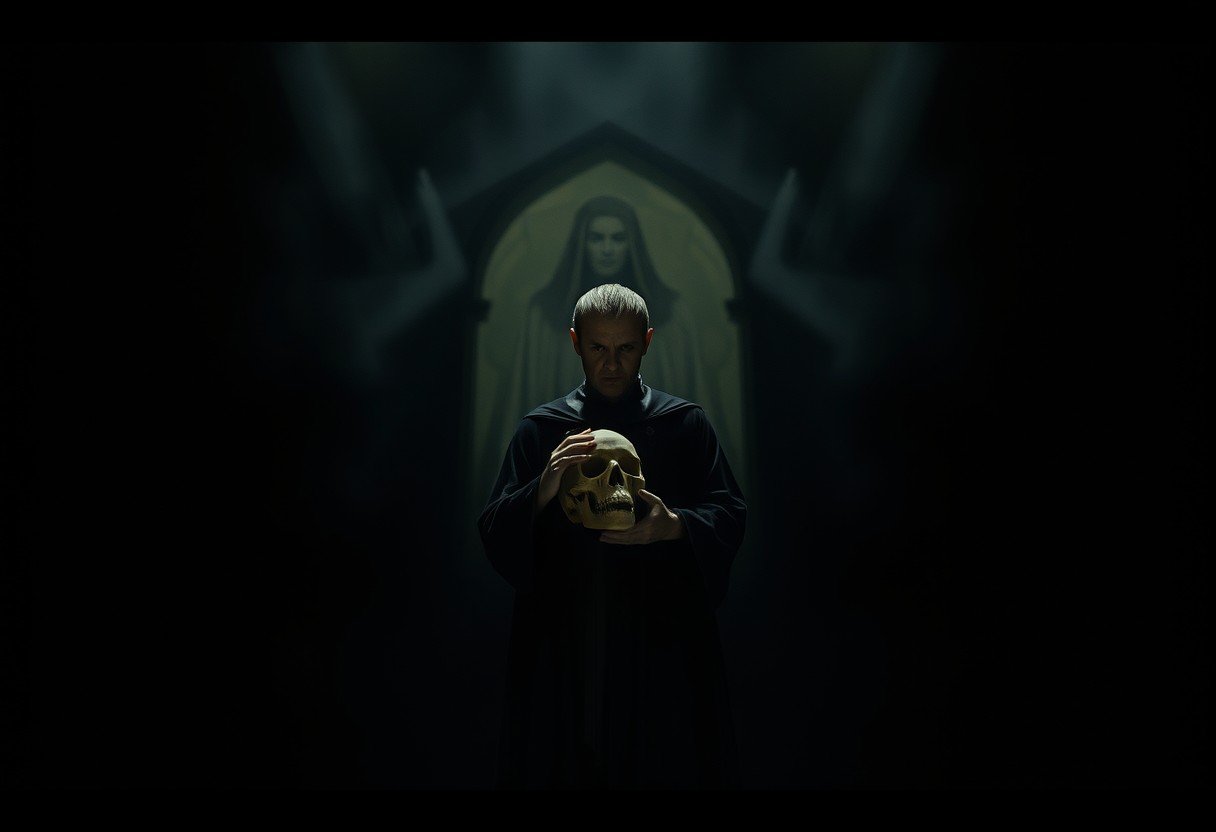When Shakespeare kills the iconic character of Hamlet, he isn’t just ending a story; he is masterfully using a set of dramatic conventions. These theatrical rules, particularly the concepts of the tragic hero and tragic irony, make Hamlet’s death a powerful and meaningful conclusion. Understanding these techniques helps explain why the play has captivated audiences for over 400 years, making us feel the weight of his fate.
What is a Dramatic Convention in Shakespeare’s Plays?
A dramatic convention is essentially a rule or technique that the playwright and audience agree upon to tell a story effectively. Think of it as the language of the theater. In Shakespeare’s time, these conventions were crucial for creating a compelling narrative without the fancy sets and special effects we have today.
These building blocks include things like a character speaking their thoughts aloud in a soliloquy or turning to the audience for a quick comment, known as an aside. The audiences of the Elizabethan era understood and expected these elements. They knew that a soliloquy was a true reflection of a character’s mind, not just random talking.
The historical context of the Globe Theatre, with its open roof and minimal scenery, meant that words and performance were everything. Conventions allowed Shakespeare to convey complex themes like revenge, madness, and morality to a diverse crowd, from the educated elite to the common groundlings.
Hamlet as the Quintessential Tragic Hero
At the heart of Hamlet’s story is the archetype of the tragic hero. This is a character who is noble and admirable but is destined for downfall because of a personal weakness, often called a tragic flaw or hamartia. Shakespeare uses this convention to make Hamlet’s journey deeply personal and emotionally impactful for the audience.
Hamlet is intelligent, moral, and a prince with great potential. However, his tragic flaw is his profound indecisiveness. He thinks so much about the consequences of avenging his father that he delays action, which leads to more chaos and death. His internal conflict between his duty to take revenge and his moral hesitation is what drives the entire play.
By making Hamlet a tragic hero, Shakespeare invites us to feel empathy for him. We see his struggles and understand his dilemma, making his eventual death feel like a true tragedy rather than just the end of a character.
| Characteristic | How it Applies to Hamlet |
| Noble Stature | He is the Prince of Denmark, a person of high rank. |
| Tragic Flaw (Hamartia) | His indecision and overthinking prevent him from acting swiftly. |
| Reversal of Fortune | He goes from a respected prince to an outcast whose actions lead to tragedy. |
| Audience Evokes Pity | His genuine suffering and internal turmoil make the audience feel sorry for him. |
The Power of Soliloquies in Revealing Hamlet’s Mind
Shakespeare gives us a direct window into Hamlet’s soul through the powerful use of soliloquies. These speeches, where Hamlet speaks his thoughts aloud while alone on stage, are a vital dramatic convention for understanding his character. Without them, he would just be a moody prince whose motivations are unclear.
In his famous “To be, or not to be” soliloquy, we witness his deep contemplation of life, death, and suicide. We feel the weight of his despair and his philosophical crisis. These moments of introspection are not just for show; they build a deep connection between Hamlet and the audience. We become his confidants, privy to his fears, doubts, and plans for revenge.
This technique makes his eventual death all the more powerful. Because we have followed every step of his tormented mental journey, his demise feels like the inevitable conclusion to an immense internal struggle we have witnessed firsthand.
How Dramatic Irony Builds Suspense for the Audience
One of the most important conventions Shakespeare uses, especially concerning Hamlet’s death, is dramatic irony. This is the technique where the audience knows something that the characters on stage do not. It creates a powerful sense of tension and engagement, as we watch events unfold, knowing the tragic outcome that awaits.
For example, we hear Hamlet’s plans in his soliloquies, so we know when he is feigning madness or setting a trap for Claudius. We watch other characters misinterpret his actions, all while we hold the key to the truth. This gap in knowledge is what makes the play so thrilling.
When it comes to his death, the audience is acutely aware of the poisoned sword and the poisoned wine in the final scene. The characters walk into a deadly trap that we can see clearly, but they cannot. This specific application is often called tragic irony, as it highlights the hero’s inability to escape his fate, a fate the audience has been anticipating with dread.
The Purpose of Death in Shakespearean Tragedy
In Shakespeare’s tragedies, death is more than just a grim ending. It is a narrative tool that drives the plot, develops themes, and provides a sense of resolution, however bleak. In Hamlet, each death serves as a catalyst, pushing the story toward its final, bloody conclusion.
The death of Hamlet’s father is what starts the entire plot. The deaths of Polonius, Ophelia, and Laertes are all direct or indirect consequences of Hamlet’s quest for revenge. These deaths are not random; they illustrate the central theme that vengeance is a destructive cycle that consumes everyone involved.
Hamlet’s own death is the ultimate culmination of this theme. It serves as the final sacrifice that resolves the central conflict and restores order to the kingdom of Denmark, as Fortinbras arrives to take over. Hamlet’s death is the tool that provides closure, weaving all the narrative threads together and forcing the audience to reflect on the devastating cost of revenge and indecision.
Key Symbols That Foreshadow Hamlet’s Doom
Shakespeare uses rich symbolism and imagery to add layers of meaning to the play, often hinting at Hamlet’s tragic fate long before the final act. These symbols help deepen our understanding of the play’s main themes, such as death, corruption, and truth.
Paying attention to these symbols gives you clues about the characters’ inner states and the moral decay within the kingdom of Denmark. They are not just decorative details; they are integral to the story.
- The Ghost of King Hamlet: The ghost represents the theme of revenge and the unresolved past. Its presence is a constant reminder of the “rotten” state of Denmark and the burden placed upon Hamlet, pushing him toward his tragic destiny.
- Yorick’s Skull: When Hamlet holds the skull of the court jester, it is a powerful symbol of the inevitability of death. This moment forces Hamlet, and the audience, to confront mortality directly, emphasizing that everyone, from kings to jesters, ends up as dust.
- Ophelia’s Flowers: The flowers Ophelia distributes in her madness each have symbolic meanings related to sorrow, flattery, and remembrance. They represent her lost innocence and the emotional devastation that has spread throughout the court.
These symbols work together to create a pervasive atmosphere of decay and impending doom, making Hamlet’s death feel like an unavoidable outcome from the very beginning.
Frequently Asked Questions about Hamlet’s Death
What is the main dramatic convention used for Hamlet’s death?
The main convention is tragic irony, where the audience is aware of the impending doom (like the poisoned sword) that Hamlet is not. This is built upon the foundation of Hamlet being a tragic hero, whose own flaw of indecision contributes significantly to his demise.
How does Hamlet’s indecisiveness lead to his downfall?
Hamlet’s tragic flaw, his inability to act, creates a domino effect of tragedy. His delay in killing Claudius allows time for more plots to develop, leading directly to the deaths of Polonius, Ophelia, Laertes, Gertrude, and ultimately, himself. His inaction creates the very chaos he sought to avoid.
Does Hamlet’s death make him a failure or a hero?
This is one of the great debates of the play. While he fails to survive, he succeeds in his ultimate goal of avenging his father and exposing Claudius’s corruption. His death is often seen as a sacrifice that cleanses the corrupt state of Denmark, making him a tragic hero rather than a simple failure.
Why do so many characters have to die at the end of Hamlet?
The high body count at the end of the play serves a thematic purpose. It illustrates the destructive and uncontrollable nature of revenge. Shakespeare shows that once vengeance is unleashed, it creates a cycle of violence that consumes not only the guilty but the innocent as well.
What does fate have to do with Hamlet’s death?
The play constantly questions the balance between fate and free will. While Hamlet makes choices that seal his doom, there is also a sense that he is caught in a destiny he cannot escape, from the ghost’s command to the seemingly coincidental events that lead to the final duel. His death is portrayed as a mix of both his personal choices and a preordained tragic path.









Leave a Comment